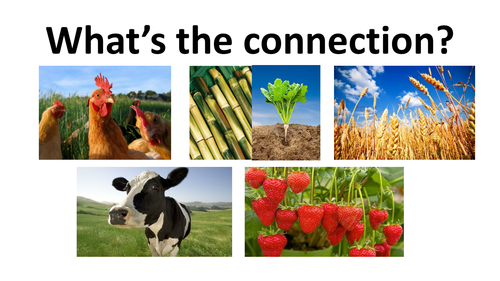

This 19 slide Thanksgiving assembly, tutor/ form time/ PSHE presentation aims to show the students how fortunate they are and to consider the problem of food waste. I have used colourful images and animations and kept text to a minimum. There are several opportunities for audience participation, pairwork, groupwork and class discussion.
The first slide has a teaser to get the students thinking. There are pictures of wheat, sugar cane, sugar beet, a chicken, a cow and some strawberries. The students have to think what the connection could be. Encourage the students to be imaginative in their responses! The second slide shows the link: the origin of ingredients to make a Victoria Sponge Cake!
Slide 3 asks How much do you THINK about the food you eat?
Slide 4 states: Thanksgiving is celebrated in North America to give thanks for the harvest. In the past lives depended on its success. George Washington proclaimed the first nationwide thanksgiving celebration on November 26th 1789. In modern times the President of the United States, will "pardon" a turkey, which spares its life!
Slide 5 states: Harvest Festivals are celebrated around the world such as….
Slides 6 – 8 name and have pictures of 3 festivals: The Blessing of the Sea in Greece, The Rice Harvest in Bali, Indonesia and Harvest Festival in the UK.
Slide 9 states: These festivals focus on giving thanks and being grateful for the food on our plate.
Slide 10 asks: How much do you THINK about the food you eat? Here is some food for thought…
Slide 11 states: These days we import food from all over the world. If our crops fail we can still eat.
Slide 12 states: Other people are not as fortunate. Today, famine is most widespread in Sub-Saharan Africa. It is caused by many factors such as drought, crop failure and war. It is also influenced by climate change.
Slide 13 shows a picture of a mountain of food and says: Here is a bumper crop. However, the following 2 clicks give the following information: Hang on………this is actually food waste.
Slide 14 shows the famine picture beside the food waste picture and asks: How do these pictures make you feel?
Slide 15 shows an infographic giving information about food waste in the USA.
Slide 16 states: Fortunately there are many individuals and groups who are doing something about food waste. For example:
• Donating to food banks.
• Composting.
• Encouraging shops to stock “ugly” produce.
There are probably locally-run groups in your area which you may want to research and perhaps even support as a school.
Slide 17 asks: Do you waste food? What can you do to reduce your waste?
Slide 18 says: This Thanksgiving take a moment to think about how lucky we are and what you can do to help others….
Slide 19 says: …including the chef! On this slide is the quotation: cooking with love provides food for the soul.
Enjoy!
The first slide has a teaser to get the students thinking. There are pictures of wheat, sugar cane, sugar beet, a chicken, a cow and some strawberries. The students have to think what the connection could be. Encourage the students to be imaginative in their responses! The second slide shows the link: the origin of ingredients to make a Victoria Sponge Cake!
Slide 3 asks How much do you THINK about the food you eat?
Slide 4 states: Thanksgiving is celebrated in North America to give thanks for the harvest. In the past lives depended on its success. George Washington proclaimed the first nationwide thanksgiving celebration on November 26th 1789. In modern times the President of the United States, will "pardon" a turkey, which spares its life!
Slide 5 states: Harvest Festivals are celebrated around the world such as….
Slides 6 – 8 name and have pictures of 3 festivals: The Blessing of the Sea in Greece, The Rice Harvest in Bali, Indonesia and Harvest Festival in the UK.
Slide 9 states: These festivals focus on giving thanks and being grateful for the food on our plate.
Slide 10 asks: How much do you THINK about the food you eat? Here is some food for thought…
Slide 11 states: These days we import food from all over the world. If our crops fail we can still eat.
Slide 12 states: Other people are not as fortunate. Today, famine is most widespread in Sub-Saharan Africa. It is caused by many factors such as drought, crop failure and war. It is also influenced by climate change.
Slide 13 shows a picture of a mountain of food and says: Here is a bumper crop. However, the following 2 clicks give the following information: Hang on………this is actually food waste.
Slide 14 shows the famine picture beside the food waste picture and asks: How do these pictures make you feel?
Slide 15 shows an infographic giving information about food waste in the USA.
Slide 16 states: Fortunately there are many individuals and groups who are doing something about food waste. For example:
• Donating to food banks.
• Composting.
• Encouraging shops to stock “ugly” produce.
There are probably locally-run groups in your area which you may want to research and perhaps even support as a school.
Slide 17 asks: Do you waste food? What can you do to reduce your waste?
Slide 18 says: This Thanksgiving take a moment to think about how lucky we are and what you can do to help others….
Slide 19 says: …including the chef! On this slide is the quotation: cooking with love provides food for the soul.
Enjoy!
Something went wrong, please try again later.
This resource hasn't been reviewed yet
To ensure quality for our reviews, only customers who have purchased this resource can review it
Report this resourceto let us know if it violates our terms and conditions.
Our customer service team will review your report and will be in touch.
£3.00